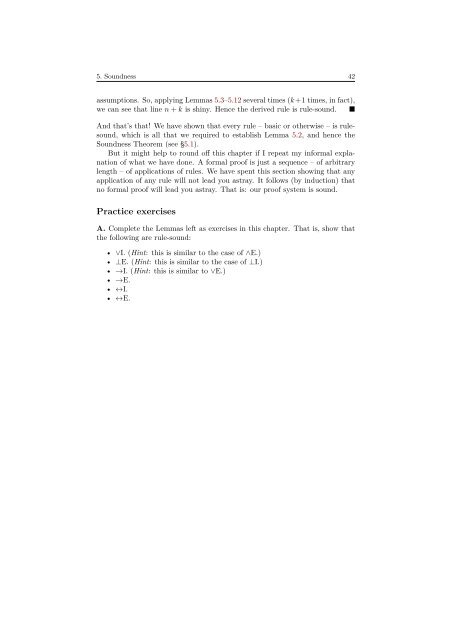Metatheory - University of Cambridge
Metatheory - University of Cambridge
Metatheory - University of Cambridge
Create successful ePaper yourself
Turn your PDF publications into a flip-book with our unique Google optimized e-Paper software.
5. Soundness 42<br />
assumptions. So, applying Lemmas 5.3–5.12 several times (k+1 times, in fact),<br />
we can see that line n + k is shiny. Hence the derived rule is rule-sound. ■<br />
And that’s that! We have shown that every rule – basic or otherwise – is rulesound,<br />
which is all that we required to establish Lemma 5.2, and hence the<br />
Soundness Theorem (see §5.1).<br />
But it might help to round <strong>of</strong>f this chapter if I repeat my informal explanation<br />
<strong>of</strong> what we have done. A formal pro<strong>of</strong> is just a sequence – <strong>of</strong> arbitrary<br />
length – <strong>of</strong> applications <strong>of</strong> rules. We have spent this section showing that any<br />
application <strong>of</strong> any rule will not lead you astray. It follows (by induction) that<br />
no formal pro<strong>of</strong> will lead you astray. That is: our pro<strong>of</strong> system is sound.<br />
Practice exercises<br />
A. Complete the Lemmas left as exercises in this chapter. That is, show that<br />
the following are rule-sound:<br />
• ∨I. (Hint: this is similar to the case <strong>of</strong> ∧E.)<br />
• ⊥E. (Hint: this is similar to the case <strong>of</strong> ⊥I.)<br />
• →I. (Hint: this is similar to ∨E.)<br />
• →E.<br />
• ↔I.<br />
• ↔E.
















